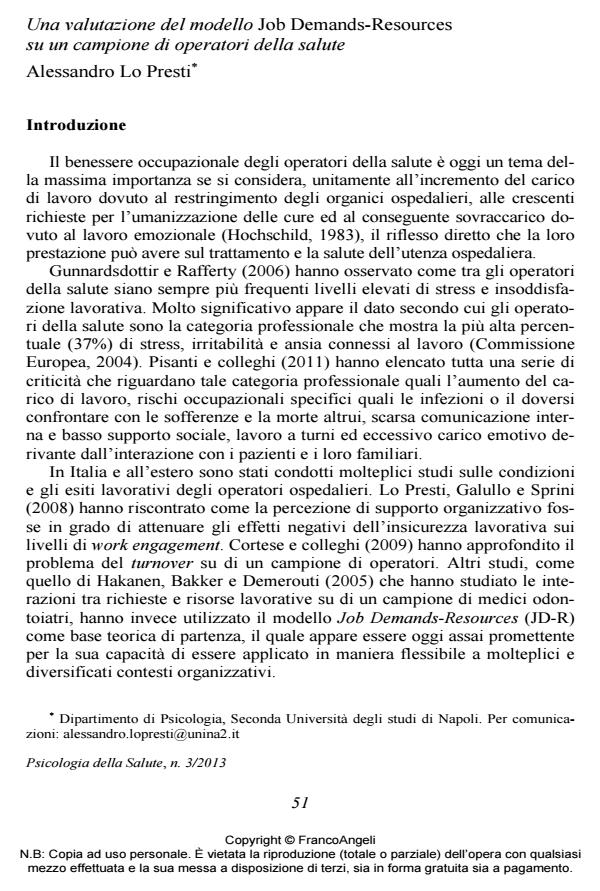An evaluation of the Job Demands-Resources model on a sample of health care workers
Journal title PSICOLOGIA DELLA SALUTE
Author/s Alessandro Lo Presti
Publishing Year 2013 Issue 2013/3
Language Italian Pages 24 P. 51-74 File size 586 KB
DOI 10.3280/PDS2013-003003
DOI is like a bar code for intellectual property: to have more infomation
click here
Below, you can see the article first page
If you want to buy this article in PDF format, you can do it, following the instructions to buy download credits

FrancoAngeli is member of Publishers International Linking Association, Inc (PILA), a not-for-profit association which run the CrossRef service enabling links to and from online scholarly content.
Occupational well-being of health care workers is an extremely important issue to public opinion, policy makers, hospital managements and social scientists. The Job Demands-Resources model (JD-R) has been successfully applied to many occupational groups for evaluating their quality of working life, and only recently, on groups of health care workers. This paper aims to explore its validity on a sample of 210 Italian health care workers. The analyses, carried out through hierarchical regressions, have revealed several significant associations, many of which conform to the evidences already available in the literature about such theoretical model. Work autonomy and occupational self-efficacy predict work engagement as well as strain (together with workload and coworkers social support). Moreover, selfefficacy and supervisory social support act as buffer with regard to the negative effects of job demands on strain and engagement. Such results have been commented on the basis of the literature and in order to stress their practical implications.
Keywords: Work engagement, strain, Job Demands-Resources model, occupational well-being, health care workers.
- Effects of individual differences and job characteristics on the psychological health of Italian nurses Maria Clelia Zurlo, Federica Vallone, Andrew P. Smith, in Europe’s Journal of Psychology /2018 pp.159
DOI: 10.5964/ejop.v14i1.1478 - Gratitude, or the Positive Side of the Relationship with Patients. Development and First Validation of New Instruments: A Scale of Gratitude Perceived by Operators and a Scale of Support Offered by the Gratitude Expressed by Their Patients Mara Martini, Daniela Converso, in Psychology /2014 pp.572
DOI: 10.4236/psych.2014.56067 - Sono presente qui e ora, e sto bene! ? Il ruolo della mindfulness nel Job Demands - Resources Model Michela Vignoli, Gerardo Petruzziello, Dina Guglielmi, in PSICOLOGIA DELLA SALUTE 2/2016 pp.106
DOI: 10.3280/PDS2016-002006
Alessandro Lo Presti, Una valutazione del modello Job Demands-Resources su un campione di operatori della salute in "PSICOLOGIA DELLA SALUTE" 3/2013, pp 51-74, DOI: 10.3280/PDS2013-003003